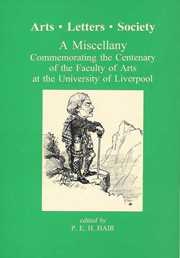 Arts - Letters - Society
Arts - Letters - Society Book contents
- Frontmatter
- Contents
- Introduction
- Preface
- PART 1 I REMEMBER ..
- PART 2 ESSAYS INFORMATIVE AND CRITICAL
- The Claims of the Arts Faculty
- The Buildings of the Faculty of Arts
- How a Redbrick Arts Faculty Worked
- The Humanities in a Technological Age
- The Real Mackay
- The Once and Future Faculty
- APPENDIX
- List of Illustrations
- Index
- Plate section
The Buildings of the Faculty of Arts
from PART 2 - ESSAYS INFORMATIVE AND CRITICAL
- Frontmatter
- Contents
- Introduction
- Preface
- PART 1 I REMEMBER ..
- PART 2 ESSAYS INFORMATIVE AND CRITICAL
- The Claims of the Arts Faculty
- The Buildings of the Faculty of Arts
- How a Redbrick Arts Faculty Worked
- The Humanities in a Technological Age
- The Real Mackay
- The Once and Future Faculty
- APPENDIX
- List of Illustrations
- Index
- Plate section
Summary
In common with other foundation disciplines of the university except the Medical Sciences, the Arts were initially housed in the old Lunatic Asylum, refurbished by Alfred Waterhouse in 1881-1883, which fronted towards Ashton Street, on the site of the present Quadrangle. Waterhouse had a reputation for economical, durable work, and the expenditure of £4,540 on heating and ventilation and, particularly, tiled decoration must certainly have transformed the asylum's interior. However, externally it remained unmodified, and for a decade this severe and uncompromisingly ‘institutional’ barrack-like building, exemplifying parsimonious charity, defeated the projection of an appropriate image for the new centre of learning. It was also grossly overcrowded and ill-equipped for other than classroom teaching, giving rise to a number of early subject departures. Chemical Science moved to its new laboratory complex in Brownlow Street (designed by Waterhouse, 1884-1887) in 1886, and Engineering Science moved into the Walker Engineering Block on Brownlow Hill (Waterhouse, 1887-1891) in 1889. The Arts were the third main academic grouping to occupy newly built premises, moving into the Victoria Building (Waterhouse, 1888-1893) on its opening in 1892.
While such relatively high prioritising of the Arts may now be surprising it had much to do with their propensity - which might well have kept them in the old asylum - for adapting to accommodation that would not have suited other disciplines. The Victoria Building was conceived as having three prime elevations (to Brownlow Hill, to Ashton Street, and to the already imagined and partly realised Quadrangle), offering no provision for the sort of ‘rear’ activities of commercial delivery and external storage associated with laboratory buildings.
- Type
- Chapter
- Information
- Arts - Letters - SocietyA Miscellany Commemorating the Centenary of the Faculty of Arts at the University of Liverpool, pp. 141 - 160Publisher: Liverpool University PressPrint publication year: 1996
- 1
- Cited by


